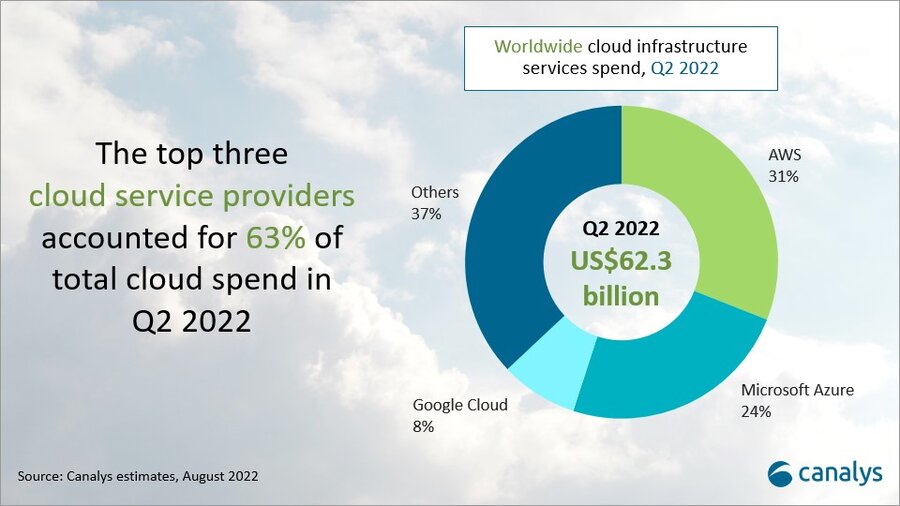Organizations paid over €60 billion for cloud infrastructure services in the past quarter, up 33 percent from the same period last year.
Market researcher Canalys publishes a report on the cloud infrastructure market once every three months. In the second quarter of 2022, organizations spent 33 percent more on services than in the second quarter of 2021. The total amount rose to $62.3 billion (approximately €60 billion).
AWS, Microsoft Azure and Google Cloud remain the largest providers. The tech giants secured 63 percent of all revenue. AWS had the largest share (31 percent), followed by Microsoft Azure (24 percent) and Google Cloud (8 percent).

Battle at the top
Canalys attributes the growth to increasing demand for cloud applications such as data analytics, machine learning, migrations and cloud-native development. Although the worldwide IT industry struggles with inflation, impact on cloud spending seems limited. When considering cost reductions, organizations rarely look towards cloud infrastructure.
AWS and Microsoft, the two largest providers, have a lot on their hands. “While opportunities abound for providers large and small, the interesting battle remains right at the top between AWS and Microsoft”, Canalys VP Alex Smith said. “The race to invest in infrastructure to keep pace with demand will be intense and test the nerves of the companies’ CFOs as both inflation and rising interest rates create cost headwinds.”
Demand pressures supply
AWS and Microsoft have major expansion plans. The tech giants bolt to keep up with demand. AWS is working on 24 new availability zones in eight cloud regions over the course of 2022 and 2023. Microsoft expects ten new cloud regions.
New data centers and servers aren’t the only solution. Microsoft recently announced that the lifecycle of servers and network equipment will be extended by two years. The tech giant wants to replace hardware after six years instead of four. Microsoft claims that customers can count on the same uptime and speed. According to the tech giant, new software detects and prevents hardware failures more effectively. Time will tell whether it works.
Collaborations are another option. “The top cloud vendors are accelerating their partnerships with a variety of software companies”, Canalys Research Analyst Yi Zhang said. For instance, Oracle and Microsoft recently launched Oracle Database Service for Azure. The service makes it possible to set up, run and manage Oracle databases from Azure. Oracle manages the service, thus lightening the load on Microsoft’s capacity.
Tip: Microsoft solves Azure’s capacity problem by using servers longer
